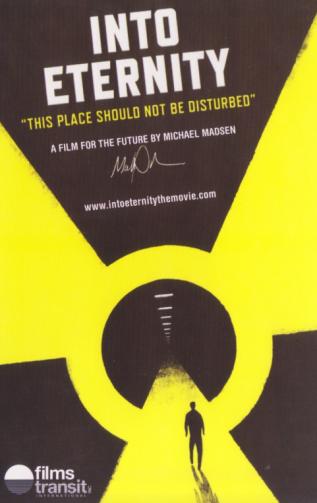
This weekend, my wife and I saw Into Eternity, a gripping documentary by the Danish filmmaker Michael Madsen. It’s well worth a wider audience, so here’s a review of it that I hope will provoke some interest.
Every nuclear power plant in the world produces several tons of high-level radioactive waste each year. In total, there exists in the world about 250,000 tons of radioactive waste, which is potentially deadly and will be for tens of thousands of years. Most countries that rely on nuclear power have no clear plan for disposing of it permanently (such as the U.S., where the proposed Yucca Mountain repository was canceled), and are resorting to temporary storage in water pools until a long-term solution is decided on.
One of the few exceptions is Finland, which is building a repository called Onkalo – Finnish for “hiding place” – drilled thousands of feet deep into the granite bedrock on an island 300 kilometers northwest of Helsinki. When Onkalo is finished, probably around 2020, it will be large enough to store all the radioactive waste Finland will generate in the next hundred years, after which it will be closed and sealed permanently.
But even though Onkalo will be open for about a hundred years, the wastes that it will contain will be dangerous for the next 100,000 years, and must be kept safe for that entire enormous span of time. That’s the almost unimaginable challenge that its builders face, and that’s the underlying idea that motivates this documentary and suffuses it with an eerily mythic, almost apocalyptic feel.
100,000 years is a span of time difficult for the human mind to grasp. The oldest pyramids of Egypt are less than 5,000 years old; the most ancient human settlements in the world, like Jericho and Çatalhöyük, are about 10,000 years old. Even the cave paintings of Lascaux are only about 17,000 years old. Onkalo will have to outlast all of these, and Madsen very effectively conveys the awful grandeur of that idea, the sense of standing at the lip of a vast abyss of time. In between interviews with the engineers, lawmakers, and scientific advisors of the project, he juxtaposes scenes of ghostly white, snow-shrouded Finnish woods with the vast, cavernous tunnels of Onkalo far below, where gloved and masked workers use heavy industrial equipment to drill ever deeper into the earth. Madsen’s narration is addressed to a hypothetical far-future audience, explaining to them why we built this place and wondering what they may think of us.
The engineering challenges in building Onkalo are formidable. For one, it’s essential that the repository be entirely passive, able to safeguard its contents without needing human beings to guard or maintain it. The engineers building Onkalo designed it to be immune to fires, floods, earthquakes – even to withstand the glaciation of the next ice age.
But natural disasters, over these long time scales, are a predictable quantity. The biggest threat to Onkalo by far is human intrusion. We can’t predict the twists and turns of contingency; we can’t be certain how long our society will endure, what may cause it to fall, or what might rise in its place. If Onkalo is ever rediscovered, some day in the far future, the people who find it may not have anything in common with us: not culture, not language, not even our scientific understanding of the world. How can we make them comprehend the danger, how can we persuade them to leave this place alone? How can we possibly communicate across the gulf of a thousand centuries?
This is where nuclear waste storage becomes less an engineering issue and more a philosophical problem. Into Eternity discusses some of the ideas that have been proposed: stone monuments engraved with warnings in every U.N. language, or more imaginative proposals that convey ideas on a level deeper than words, like huge, forbidding black monoliths or a jagged “landscape of thorns” protruding from the earth. One interview subject suggests reproductions of Edvard Munch’s “The Scream”. Still others suggest that any marker at all will only invite curiosity, and the best thing we can do for our descendants is to seal up Onkalo and leave it entirely unmarked and forgotten, hoping they never stumble across it.
Although this isn’t explicitly an environmental documentary, the subject looms unavoidably in the background. Paradoxically, the building of Onkalo shows both the worst and the best of humanity: how insanely selfish and short-sighted it is to light our homes and offices today with a poison that will endanger our descendants for hundreds of generations; and how inspiring it is that we’re able to think this far into the future and be willing to consider such extreme measures to safeguard them. But the most terrifying idea of all is that Onkalo, as huge as it is, will only store the nuclear waste of one country. Ultimately, the world will need dozens or hundreds of places like this. How many hidden dangers, how many buried traps, are we going to have to leave for those who live after us?